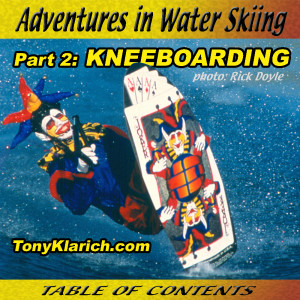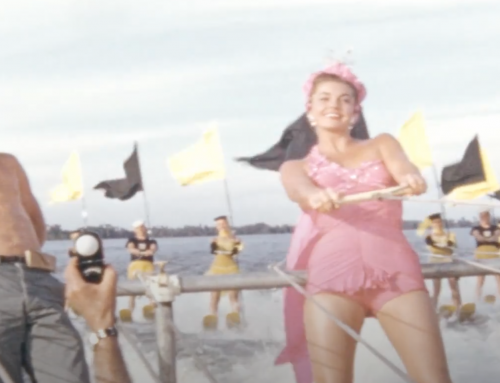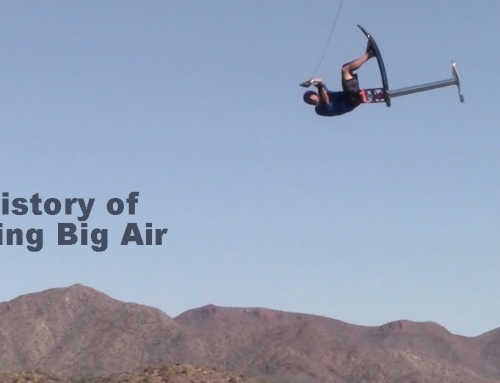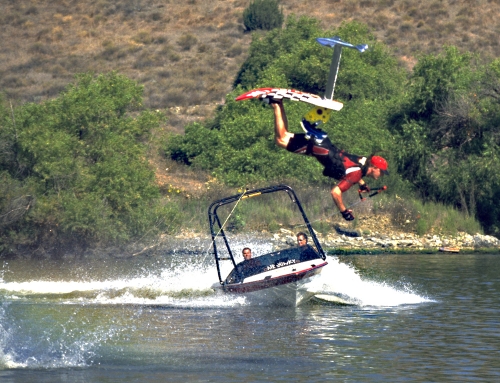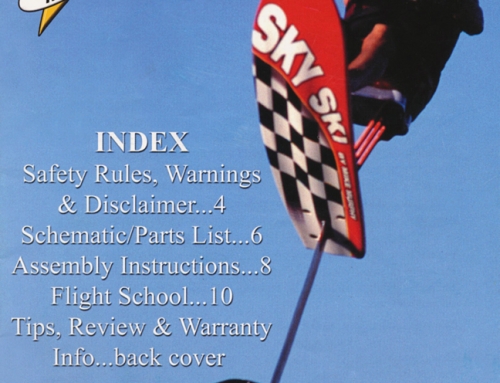10: RIDING THE WAVE – COMPETITIONS
In the early 1980s watersports enthusiasts were excited about kneeboarding. The industry was pumping money into the market with new designs and an advertising blitz. More riders than ever were getting good on a kneeboard, and companies like Hydroslide, O’Brien, Connelly, and Ski Master were giving free product to the cream of the crop. The next logical step was competitions.
Andy Remy, Ken White and Tom Christensen were the first promoters of organized competitions in Texas. The first National competitions were held in 1981 and 1982.[i][ii] Remy continued with a series of tournaments in 1983 and 1984.[iii][iv]
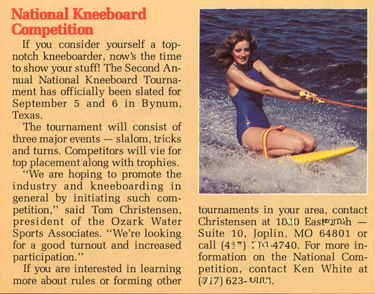
According to This 1981 Article, the First “Nationals” Would Have Been in 1980
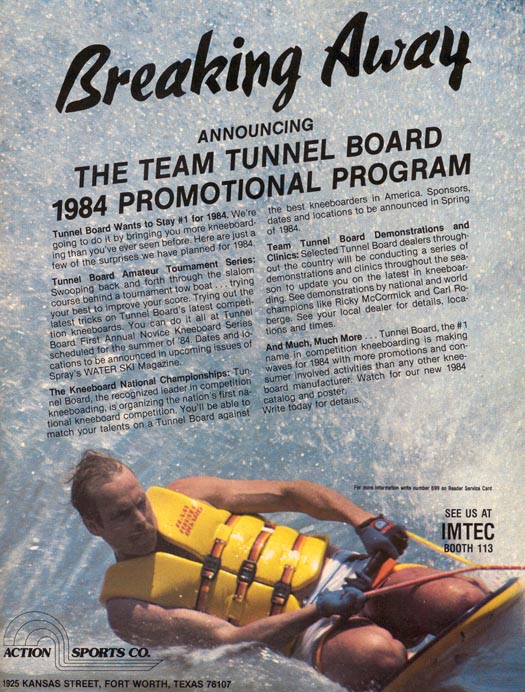
Andy Remy at Tunnel Board Organized Some of the Earliest Competitions, 1983
Next came Roland Hiller, the 1965 World Overall Champion in 3-event skiing. Hillier got into promoting tournaments just when the money started coming into the sport. He formed the International Kneeboard Association (IKA) with his wife Francesca in September 1983, and Roland became the dominant force directing the events.[v] The IKA competitions were the first to draw the world’s best kneeboarders, initially from Florida, and eventually from across the nation.
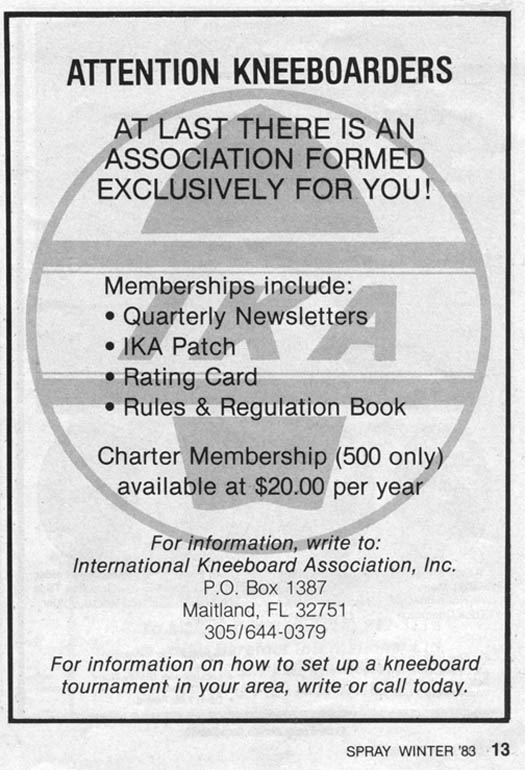
Hillier’s IKA Gave Kneeboarding a Much Needed Organizing Body.
Hillier was an innovative promoter, adding events that even novice riders could do without any special courses. Tricks and wake jumping were the original two events.[vi] The advantage was that riders could practice anywhere, and tournaments did not need any special courses. Wake jumps much like wake crossings in barefooting competitions. A set time was given to do as many wake-to-wake crossings as possible, with or without a jump. The marquis kneeboarding event was tricks. The big moves were wake 360s and the newly invented backside roll.
Ted Bevelacqua was the early favorite, and star of the IKA.[vii] The self-described “skinny little kid” from Florida was big on skills and had an exuberant joy of riding. Ted’s board never fit quite right, so he took an old guitar strap and all the Velcro he could find to piece together the first triple locking kneeboard strap. It worked, and riders wanted them. Ted started Pro-Acqua, the first company for aftermarket kneeboard products.[viii] Another one of Ted’s innovative designs was the Pro-Acqua binding. It was a horseshoe shaped neoprene pad that a rider glued onto the back of their existing pad for customized ankle support.
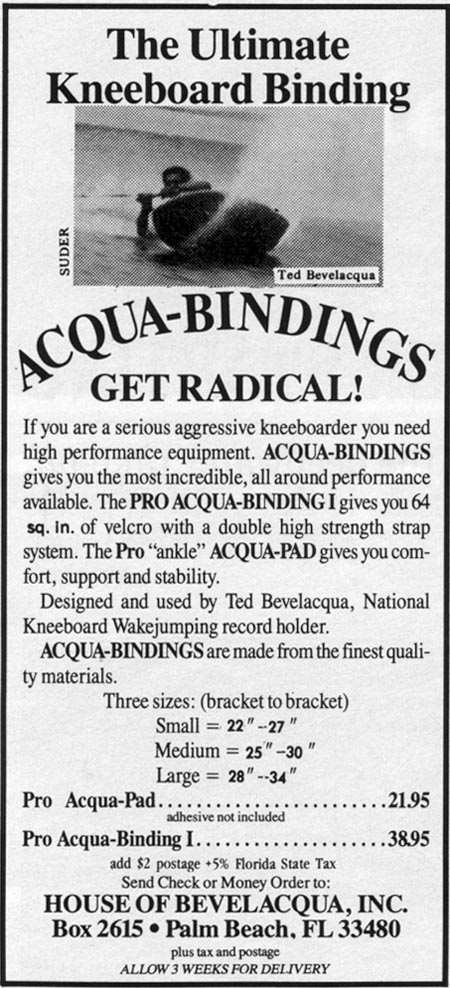
Teddy B was the First Major Player in the Aftermarket Products, 1984
***
The competition scene was heating up in Florida, and I badly wanted to test my skills against guys like Ted, Paul Roberts, and Mario Fossa. Uncle Mike was friends with Danny Churchill, so he introduced us. I signed with Hydroslide who agreed to pay my expenses to the tournaments. My first kneeboard competition was in 1984 at the 3rd IKA Nationals on Lake Ivanhoe in Orlando, FL. It was the first time someone travelled so far to come to an IKA event, and my presence helped the event actually live up to its name for the first time. Unfortunately, my equipment got misplaced by the airline, and didn’t make it in time for the tournament. I scrambled to borrow a rope, board, and vest; and my best finish was 3rd place in tricks. By this time a slalom event had been added. Riders weaved back and forth between a straight line of fixed buoys. To increase the difficulty the boat went faster and faster.[ix] The original slalom course used by kneeboarders was a modification of the slalom course used by stand up skiers in the earliest days of traditional competitions.
HO Sports and Hydroslide were paying my expenses to tournaments, exhibitions, and photo shoots. This was most often to the center of the skiing universe in the 1980s: Orlando, FL. In April 1985 I found myself on Lake Eola getting ready to kneeboard and hot dog slalom ski for the newly formed Coors Light International Water Skiing Tour.[x] Danny Churchill set it up through Hydroslide who was a sponsor of the Tour. It was my biggest show so far, and the demonstration was even more of a rush than performing as a show skier at Magic Mountain. For the first time, I was on the same water as my ski heroes; Sammy and Camille Duvall, Bob Lapoint, Andy Mapple, Deena Brush…they were all there. The world’s best skiers were battling it out, and all I had to do was a few jumps, wake helicopters, and flips to wow the crowd of several thousand. Any invert on the kneeboard was still a novelty that people were excited to see. For most it was the first time they ever saw someone flip a kneeboard in person. For ski fans that couldn’t make the actual event the whole thing was broadcast on cable television.
Joining up with Danny Churchill and Hydroslide was the right move to get big exposure. This included some serious ink in the trade magazines. Danny pitched me as a package deal: top kneeboarder, show skier, and hot dogger. He used me in a good way to help promote Hydroslide through two national publications based on the west coast. Powerboat magazine ran a feature story, including my first cover in April, 1985. The five -page spread featured kneeboarding and hot dog slalom skiing, both up and coming disciplines in the mid 1980s. I was once again following in my uncle Mike’s wake. He made the cover of Powerboat in June, 1975. Danny also hooked me up with Trailer Boats magazine, which also ran feature story in 1985 called “Hydroslide Hotdoggin’.” It ran with lots of pictures, including the first front flip sequence on a kneeboard.[xi]
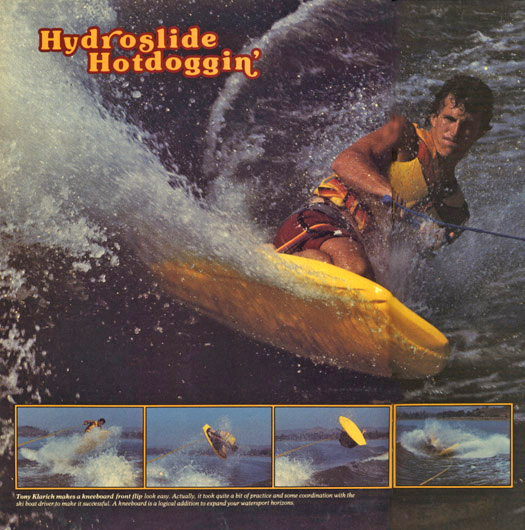
Danny Churchill Hooked Me Up With the Magazines. (Youngs, 1985)
Complete Trailer Boats Feature Story
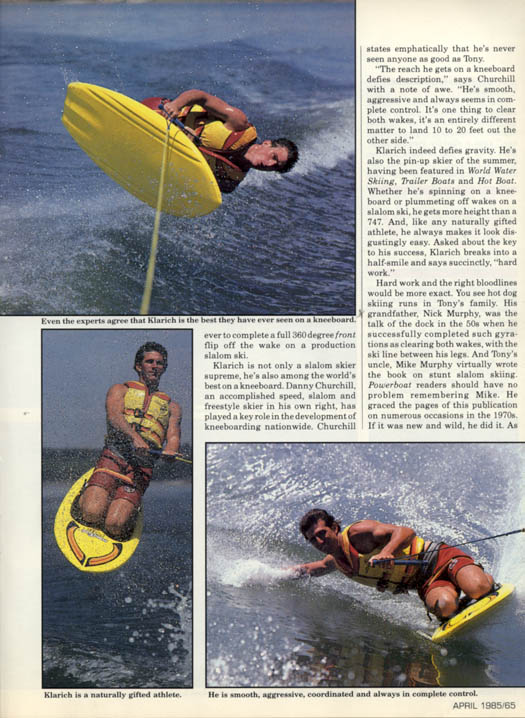
Kneeboarding was Going Mainstream, and I Rode the Wave. (Spencer, 1985)
Click to Read the Entire Powerboat Story
My grandpa Murphy was so proud: he plastered copies of those magazine pictures inside the walls of his red truck, right next to the articles about Mike. Woe to any gas station attendant who got a little too close to the shrine!
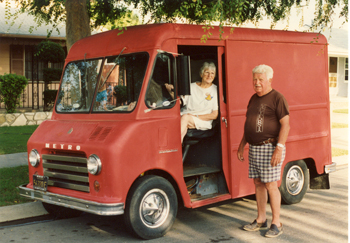
Grandma & Grandpa with the Famous Red Milk Truck
***
The battle for control of the hearts and minds of competitive kneeboarders was heating up. Hillier had been promoting IKA events for several years, and he tried to use his position to direct and control the sport. That may not have been a bad thing, but it was a hard sell to exert authority over a sport that was based on a free spirited attitude. Opinions differed greatly over what should happen, and who should be in charge. In response to the debate, a group of dedicated kneeboard enthusiasts from the Midwest stepped in and created the American Kneeboard Association (AKA), with the first sanctioned tournament taking place on Bayou Plaquemine in LA in October, 1994.[xii]
Lonnie Marchand, Chuck Purdy, Randy Andrus, and Richard Brown were on the initial board of directors. The AKA based their organization on the structure used by the American Water Ski Association (AWSA), the governing body of water skiing in the United States.[xiii] This put an established framework in place upon which to build. They used AWSA standards for training judges (there were now three instead of just one), and certifying drivers and safety directors. The decision to follow AWSA guidelines changed event promotion from a one-man show to a cooperative effort.
Between 1983 and 1985 riders were split over which events to attend: IKA or AKA. Some people took sides, and hard feelings were often the result. Regardless of the disagreements and power struggle for control of competitions, two associations meant that kneeboarding was getting popular. Riders all over the country practiced for tournaments, and skill levels skyrocketed. Events offered a gathering place for riders to learn from the sport’s top athletes, show off new moves, and talk about the exciting future of kneeboarding.
Support for the IKA dwindled in the wake of hotly disputed results at the 1985 IKA Nationals. Hillier did a fantastic job at promoting the sport, including writing the first instructional book in 1985, “but kneeboarding had outgrown the days of one person having so much authority. It was time for the group to take charge. The newly formed American Kneeboard Association was now the organization left to carry the torch for competitive kneeboarding.
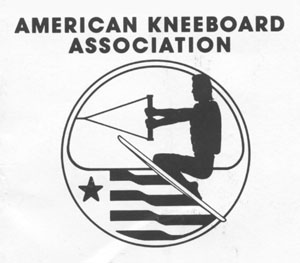
The AKA was a Group Organization Based on the AWSA (American Water Ski Association)
My history in kneeboarding, and years of show skiing experience put me in an excellent position to do well in competition. In 1985 and 1986 I took 1st place overall in the open division at the first two AKA Nationals held down on the bayou in Plaquemine, LA.[xiv]
Events included spins, slalom, and tricks. Spins were a holdover from the days when people were just learning how to ride. How many 360s you could do in a set time was not very compelling. The event was discontinued in the top divisions after lots of ties and reruns.
The slalom event was a real challenge that I excelled at. It helped that I had spent a couple of summers running the course on a slalom ski. That experience allowed me to break the National record numerous times. The Men’s Open division used a standard six-buoy slalom course with a top speed of 24 mph. Running the course at 32’ or 35’ off was a good score. Shorter lines and higher speeds made it easier to negotiate the smaller wakes and stay low to the water. Many riders used a specialized board just for the slalom event.
Tricks was the event that generated the most excitement. I used my background in hot dogging and freestyle jumping to land the first front flip and wake 540 front to back at an AKA event. In 1985 and 1986 stand up tricks were still allowed, and I took advantage by filling one complete pass with those high scoring moves. The 20 bucks I lost on the bet with Mike paid off with several National records.
Stand Up Tricks: Wake 360 & More
The Manion family was among the first to switch to the AKA. Mary Manion knew the AKA needed industry support, and contacted Danny Churchill at Hydroslide. Churchill agreed to include AKA promotional literature with each Hydroslide that was sold. Mary wrote numerous articles for all the major trade magazines to spread the word about the fun and challenge of competitive kneeboarding. Writing about the top riders was a no-brainer, but she also emphasized the family aspect of kneeboarding. Her hard work for the AKA resulted in a sponsorship from Nautique boats for her family, a first in kneeboarding. She helped form the popular MAP kneeboard club, an acronym for the founding families of Manion, Andrus, and Piper.
The early days of the AKA were helped by the structure of the AWSA, but events were still more about fun than serious rules. I was among those who got to ride even after missing a mandatory riders’ meeting. Even showing up late for a start time would often result in still getting to ride later.
With all the best kneeboarders attending the same events starting in 1986, there was an explosion of new tricks at almost every tournament. Several of the best riders attended each of the dozen or so tournaments held each year.
Mario Fossa was one of the riders who came to the AKA events with his new tricks. We were impressed with his surface roll, similar to a barefoot tumble turn, but it was his new way to flip that really got people excited.[xv] Mario’s breakthrough move was called the wake jump to air roll. Mario flew low and fast across both wakes on a regular jump, then bounced in the flats to throw a backroll without the wake. A whole new avenue of tricks was opened up. Another long running specialty for “Super Mario” was the flip out. He was among the first to flip in both directions. The rules were simple: do as many flips as possible in 20 seconds.
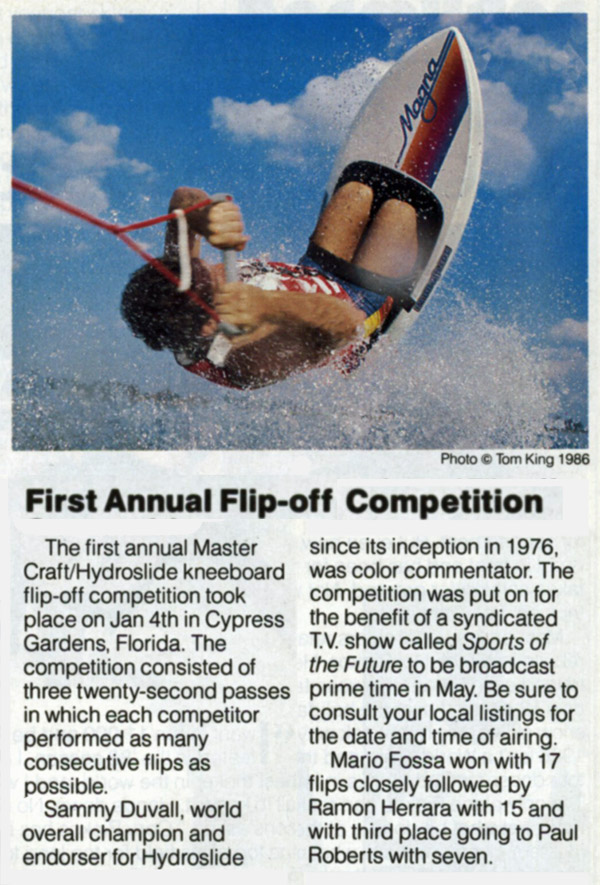
“Super Mario” Fossa was the “King of Dizzy”, (King, 1986)
Getting Dizzy with Mario Fossa (1993)
Most tournaments had the Flip Out, but scores were not included in scoring for the overall title. I never really pursued the Flip Out, even though Hydroslide was putting up cash prizes. It was hard for me to get motivated to train for flips back and forth across the wake. I was a showman who wanted to keep onlookers engaged with my riding. To me, the same flip after flip was just plain boring. The Flip Out was a great incentive to get people inverted in the early days, but after a while the event got monotonous.
Lance Walker grabbed attention in the mid 1980s with a high-flying move he called the “Layout.” We had another name for the cool looking move. The Star Wars trilogy was in its original release, so we called Lance and his signature move “Skywalker.” The trick was probably a crossover from a cable skiing move called the “Flying Indian.” Steve Fontaine used a pair of jump skiis to get laid out on the corner of the cableway.[xvi] But it was Lance who was the first one to do a Layout directly behind the boat. His innovative trick can best be described as Air Raley on a kneeboard, but he did it several years before Darin Shapiro made one on a wakeboard in 1991.
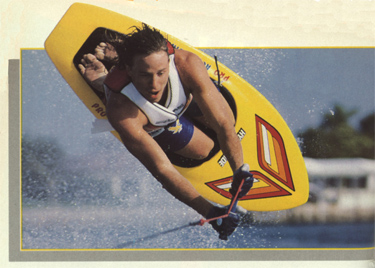
Lance Walker was the First to Do a Layout Behind the Boat. (King, 1986)
1986 Hydroslide Promotional Video with Lance Walker, Mario Fossa, Ted Bevelacqua, Mike Reinman, Paul Roberts, Kent McMillan, Ramon Herrera, and Sammy Duvall.
Ramon Herrera was another early inventor of new tricks. He is credited with unknowingly landing the first wake front roll, an off axis attempt at a front flip.29 He also used his catlike riding style to take Mario’s jump to roll combo to the next level. Ramon threw a big backside roll across the wakes, then he bounced directly into another roll: he did not hesitate between the flips. The introduction of the combo roll really opened the door for a whole new category of exciting new moves, and much later the concept had a dramatic impact on sit down hydrofoiling.
Ramon Herrera was One of the Early Stars of Kneeboarding. (Dorner, 1985)
With the newfound celebrity of riders, and the high interest in competitions, the industry promoted kneeboarding heavily. Money was spent in advertising and promotions. The magazines regularly featured instructional articles and colorful pictures of us flying and flipping. Now, for the first time, instruction for the new moves was widely available. Our tips and tricks were plastered in every issue of Water Ski magazine, and several instructional videos were produced and sold.[xvii] [xviii][xix] Mario and Ted lead the way as live instructors at ski schools specializing in kneeboarding.[xx] It was the first time in waterskiing that the thrill and excitement of flips and fun was available to recreational riders. More people than ever bought boards and took them out to get dizzy.
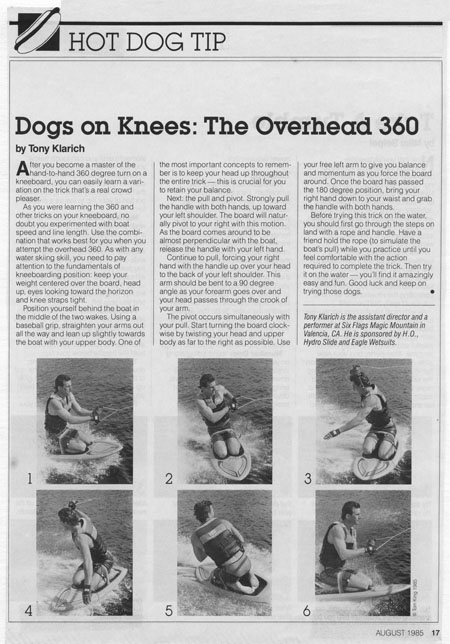
Instruction Became a Magazine Mainstay, and I Wrote Dozens of Tips. (King, 1985)
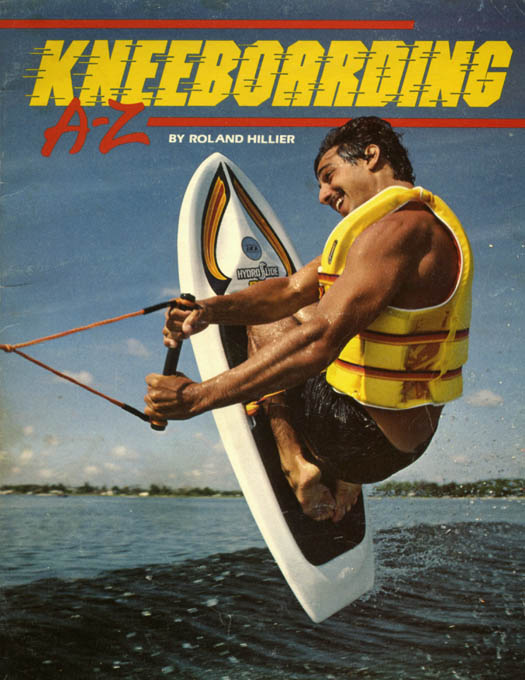
IKA Founder Rolland Hillier Wrote the First Kneeboarding Book, 1985
Many riders got sponsored, and the top tier even started earning decent money as professional kneeboarders. A select few of us became recognizable in the larger water skiing circle.
Mike “Rhino” Reinman was known for his aggressive style and go for it attitude. Rhino started out exclusively on the Ski Rixen cable in Deerfield Park, FL. He was one of the earliest kneeboarders to generate air on the sharp turns of the cable course.30 One advantage to the cable is the upward pull of the rope, and Rhino used the floating effect to land another spectacular move in kneeboarding: the backwards back flip.29 He cut out in the corner and turned backwards just before the rope lifted him off the water. While he was in the backwards position he threw his head and shoulders and performed a backwards flip. Once Rhino transferred his skills from the cable to behind the boat he became an intense competitor who always challenged for top honors.
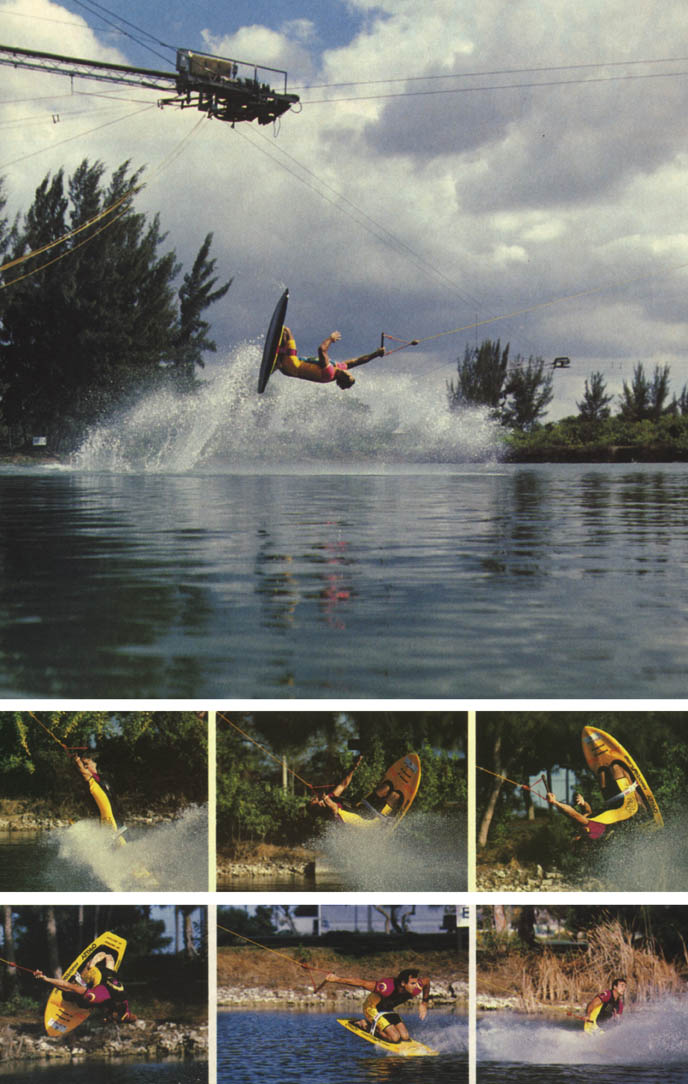
Mike “Rhino” Reinman & His Creation: Backwards Back Flip on Cable. (King, 1990)
I wanted to add another big trick to the growing list, but my pursuit lead to plenty of pain. The mobius was one of the new tricks being demonstrated on the Water Ski Pro Tour by freestyle jumper Scotty Clack. He came into the ramp wrapped while riding two jump skis. The maneuver was a back flip with a full twist, and it was a crowd favorite. It didn’t look easy, but it did look like something that was doable on a kneeboard. I could already do a back flip on jumpers off the ramp, and helicopters on the kneeboard were no problem, so combining the two shouldn’t be that hard. I took my orange Hydroslide Pro out for a spin at the Marine Stadium. My thoughts were to get plenty of height, throw the gainer straight back, and let the rope do the spinning. The first few tries were close enough; I was coming around, but loosing the handle. On the forth or fifth try I under rotated the gainer and caught the tip of my board. I went straight out the front, and my right arm went into the handle almost to my armpit. The line came tight and the handle wrenched my arm as it got violently yanked out. What happened next was like the scene from the recently released Michael Jackson video Thriller. My arm literally transformed right before my eyes. It went from normal size to three times as big in a matter of minutes. I could barely lift it. Grandma used to freeze water in old milk cartons for the ice chest, and I tore into one to try and get the swelling down. I iced my arm continuously over the next few hours, and it seemed as if the worst was over. Not so. My injured arm throbbed for at least an hour every night for the next eight months. The daily pain reminder must have been a mental block for me and the mobius. That’s one trick I never made on the water.
While we worked on creating new moves, the equipment moved forward too. New boards, with design input from riders, were being released at a steady rate. The knee strap made another stride forward thanks to Lonnie Marchand. He created a single piece triple locking strap that was not fixed at the footman loops. Lonny’s new Cinch Strap was the first to fit a wide range of riders. That was a huge step for the majority of people who shared a kneeboard. Lonnie continued developing his strap and a couple of years later came up with the breakthrough that became the industry standard. His 2 to 1strap was a triple job that was fixed on one side. After the second layer was secured, the third went through a D ring on the strap itself before folding over. This neat little addition meant that a rider pulling on the top strap was able to pull twice as hard with the same effort. For serious riders it was easier than ever to get a secure fit on the board.
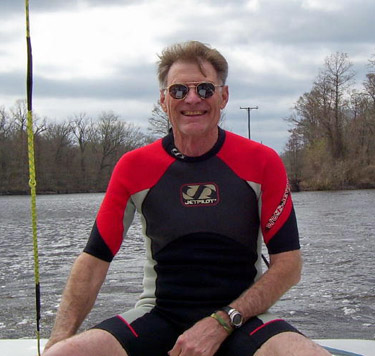
Equipment Pioneer Lonnie Marchand
>Adventures in Water Skiing: SERIES LINKS
Images (used with permission)
“Adventures in Water Skiing: Part 2, Kneeboarding,” photo Rick Doyle, 1994.
“National Kneeboard Competition,” World WaterSkiing, Sept, 1981, 17.
“Breaking Away – Tunnnel Board Ad,” World WaterSkiing, Fall, 1983, 79.
“First IKA Ad,” Spray’s WaterSki, Winter, 1983, 13.
“Pro-Acqua Ad,” Spray’s WaterSki, June, 1984, 20.
“Hydroslide Hotdoggin’,” photos Jim Youngs, Trailer Boats, June, 1985, 60-61.
“Tony!,” photos by Mark Spencer, Powerboat, April, 1985, 65.
“1st Flip-off Competition – Fossa,” photo Tom King, WaterSki, May, 1986, 13.P “Lance Walker Layout,” photo Tom King, WaterSki, June, 1986, 64.
“Ramon Herrera Cover,” Photo Terrence Dorner, WaterSki, June, 1985.
“Dogs On Knees – Klarich,” photos Tom King, WaterSki, August, 1985, 17.
“Reinman on Cable,” photos Tom King, WaterSki, August, 1990, 101.
References
[i] “Ski Master Ad,” Spray’s WaterSki, Sept, 1981, 45.
[ii] World WaterSkiing, Sept, 1981, 17.
[iii] “Kneeboard Issue,” Spray’s WaterSki, July, 1983, 8.
[iv] “Novice Kneeboard Series,” Spray’s WaterSki, Fall, 1983, 30.
[v] World WaterSkiing, June, 1984, 49.
[vi] “Kneeboarding Grows Up,” Spray’s WaterSki, June, 1984, 7.
[vii] Roland Hillier, “3,2,1, Ignition…Blast Off,” Spray’s WaterSki, June, 1984, 45.
[viii] “Pro-Acqua Ad,” Spray’s WaterSki, June, 1984, 20.
[ix] “The Start of Something Big? – The International Kneeboard Association,” World Water Skiing, June, 1984, 48.
[x] “It’s Showtime!,” WaterSki, July, 1985, 86.
[xi] Jean Muckerheide, “Hydroslide Hotdoggin’,” Trailer Boats, June, 1985, 60.
[xii] “Newsmakers – American Kneeboard Association,” WaterSki, May, 1985, 14.
[xiii] “Tournament News,” WaterSki, Nov/Dec, 1985, 75.
[xiv] “AKA Past Kneeboard National Champions,” accessed July 12, 2012, http://www.usawaterski.org/pages/divisions/kneeboard/AKAPastChampions.htm
[xv] Mario Fossa, “Kneeboarding: Evolution of a Sport,” WaterSki, July, 1989, 74.
[xvi] Terry Temple, “Cable Vision,” WaterSki, September, 1985, 38.
[xvii] Steve Merritt, “Ultimate Kneeboard Experience – Instructional Video,” WaterSki, April, 1987, 127.
[xviii] HO Sports, “Let’s Go Skiing (with kneeboard instruction), WaterSki, May, 1987, 81.
[xix] Ted Bevelacqua, “Get Radical,” WaterSki, Nov-Dec, 1987, 72.
[xx] “Kneeboarding Hits Ski Schools,” WaterSki, Nov-Dec, 1986, 71.
Some Rights Reserved. The TEXT ONLY of this publication MAY be used or reproduced in any manner whatsoever without written permission. All use MUST be accompanied with the attribution: “From Adventures in Water Skiing: Part 2, Kneeboarding. Used with permission by http://tonyklarich.com”. TEXT ONLY is licensed under creative commons agreement (CC BY 3.0). The images (photos) MAY NOT be used, uploaded, reposted, or reproduced in any manner whatsoever without written permission.










